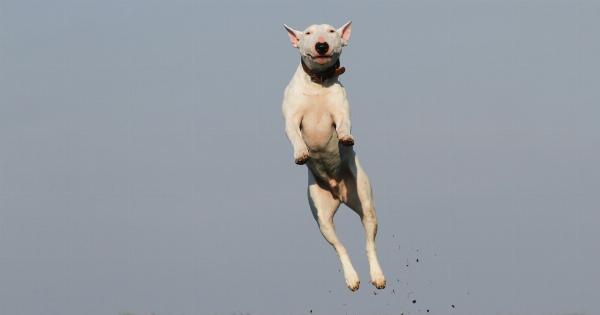Dogs are known to be remarkable companions and incredible sources of joy. However, like humans, dogs can also experience fear and develop phobias.
Just like humans, dogs can develop phobias at any age, but certain periods in their lives may make them more susceptible to developing fears and anxieties.
Early Socialization Period
From birth to about 12 weeks old, puppies go through a critical period known as the early socialization period. During this time, they are highly receptive to new experiences, people, and other animals.
Proper socialization during this period is crucial as it helps puppies develop confidence and positive associations with their environment.
Exposure to a variety of people, sounds, sights, and surfaces is essential to help puppies grow into well-adjusted adult dogs.
If a puppy is exposed to positive experiences during this period, they are less likely to develop phobias and fears later in life.
Adolescence
Just like humans, dogs also go through adolescence. This period occurs between six months to two years of age and is marked by physical and hormonal changes. During adolescence, dogs may become more independent, adventurous, and curious.
However, it is also a time when anxieties and phobias may develop.
Adolescence can be a challenging time for dogs as they navigate new experiences and hormones.
If the adolescent dog has not been properly socialized or had negative experiences during this period, they may be more prone to developing phobias and anxieties.
Traumatic Experiences
Regardless of age, a traumatic experience can trigger the development of phobias in dogs. Dogs that have experienced significant trauma such as abuse, accidents, or exposure to natural disasters are more likely to develop fears and phobias.
It is essential to provide support, comfort, and professional help to a dog that has experienced trauma. With proper care and guidance, even dogs that have suffered traumatic experiences can overcome their fears and live happy lives.
Genetic Factors
Just like humans, dogs can inherit certain predispositions and tendencies from their parents. Some dog breeds may have a higher likelihood of developing certain phobias and anxieties due to their genetic makeup.
For example, some herding breeds like Border Collies may be more prone to noise phobias due to their highly sensitive nature. Breeds such as Greyhounds have been shown to have a higher incidence of separation anxiety.
Understanding the breed-specific tendencies can help dog owners take preventive measures and provide support to their furry companions.
Signs of Canine Phobias
It’s important for dog owners to be aware of the signs that their dog may be experiencing a phobia. While a certain degree of fear is normal and can help dogs stay safe, excessive or irrational fear may indicate a phobia.
Some common signs of canine phobias include:.
1. Trembling and shaking:
Dogs may tremble and shake uncontrollably when faced with their phobia. This physical reaction is an outward manifestation of their fear and anxiety.
2. Excessive drooling:
Dogs experiencing a phobia may salivate excessively. This is an automatic response to fear and stress.
3. Panting and rapid breathing:
Rapid breathing and panting are common signs of fear and anxiety in dogs. It is their body’s way of preparing for a potential threat.
4. Hiding or attempting to escape:
If a dog encounters their phobia, their immediate response may be to hide or try to escape from the situation. This behavior is an instinctual attempt to protect themselves.
5. Destructive behavior:
Some dogs may exhibit destructive behavior when faced with their phobia. They may chew on furniture, scratch walls, or destroy other objects in an attempt to cope with their fear and anxiety.
6. Aggression:
In extreme cases, dogs may respond to their phobia with aggression. This aggressive behavior is a defensive reaction, intended to keep the perceived threat at bay.
7. Loss of appetite:
When faced with a phobic trigger, dogs may experience a loss of appetite. The fear and anxiety they feel can overpower their desire to eat and drink.
8. Excessive barking or howling:
Sometimes, dogs may express their fear and anxiety through excessive barking or howling. This can act as a way to communicate their distress and seek help from their owners.
9. Freezing or becoming immobile:
Some dogs may freeze or become immobile when faced with a phobic trigger. This response is a result of their fear overwhelm.
10. Peeing or pooping indoors:
In extreme cases, dogs may lose control of their bladder or bowels when faced with an intense phobic trigger. This is a physical response to extreme fear and stress.
Seeking Professional Help
If a dog is exhibiting any of the above signs of phobias, it is essential to seek professional help. Veterinarians and animal behaviorists can help diagnose the phobia and develop an appropriate treatment plan.
This may involve desensitization and counter-conditioning techniques, medication, or a combination of both. With the right guidance and support, dogs can overcome their fears and live happier lives.
Conclusion
Dogs can experience phobias at any age, but certain periods in their lives may make them more vulnerable. Early socialization and positive experiences play a crucial role in preventing the development of phobias.
Traumatic events can trigger phobias, and genetic factors may also contribute. Recognizing the signs of canine phobias and seeking professional help is essential to ensure the well-being and happiness of our furry companions.





























